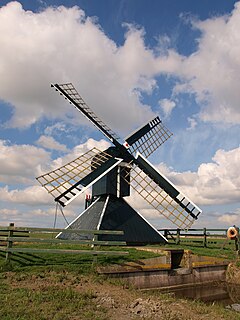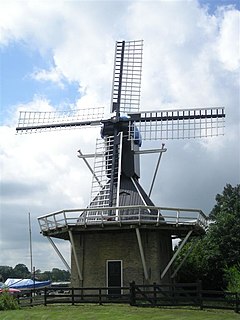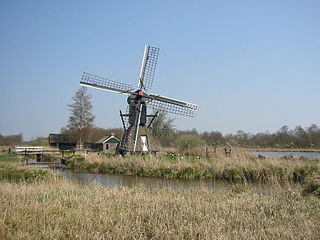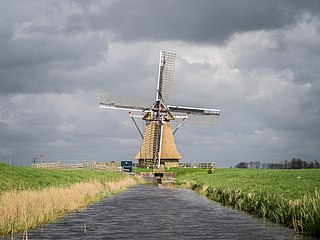
Mellemolen, formerly known as the Polslootpoldermolen or Spookmolen is a hollow post mill in Akkrum, Friesland, Netherlands which has been restored to working order. The mill is listed as a Rijksmonument, number 35937.

Arkens is a Hollow Post mill in Franeker, Friesland, Netherlands which has been restored to working order. The mill is listed as a Rijksmonument, number 15710.

De Modderige Bol is a Hollow Post mill in Goëngahuizen, Friesland, Netherlands which has been restored to working order. The mill is listed as a Rijksmonument, number 34001.

Heechheim is a Hollow Post mill in Goëngahuizen, Friesland, Netherlands which has been restored to working order. The mill is listed as a Rijksmonument, number 33999.

Kramersmolen is a hollow post mill in Goutum, Friesland, Netherlands which was built in 2002. The mill is listed as a Rijksmonument, number 24508.

Molen Hoogland is a Hollow Post mill in Goutum, Friesland, Netherlands which was built in 2004. The mill is listed as a Rijksmonument, number 24521.

De Groene Molen is a hollow post mill in Joure, Friesland, Netherlands which was built c1800. The mill has been restored so that it can turn by wind. It is listed as a Rijksmonument, number 18208.

Meerswal is a smock mill in Lollum, Friesland, Netherlands which was built in 1903. The mill has been restored to working order and held is reserve for use in times of emergency. It is listed as a Rijksmonument, number 39364.

Terpzigt is a drainage mill in Marssum, Friesland, Netherlands. It is the smallest spinnenkop, a type of hollow post windmill. The mill is listed as a Rijksmonument, number 8625.

The Geeuwpoldermolen is a drainage mill near the twin village of Oppenhuizen, Friesland, Netherlands. It is a hollow post windmill of the type called spinnenkop by the Dutch. The mill is listed as a Rijksmonument, number 39810 and it is still in use for draining the Geeuwpolder. It was almost completely renewed at a restoration in 1987, earlier restorations were in 1954 and 1965.

Doris Mooltsje is a drainage mill near the village of Oudega, Friesland, Netherlands. It is a hollow post windmill of the type called spinnenkop by the Dutch. The mill is listed as a Rijksmonument, number 527647 and has been restored to working order in 1998.

The Himriksmole, also known as Groene Ster after the recreational area and nature reserve where it is located, is a drainage mill near the village of Tytsjerk, Friesland, Netherlands. It is a hollow post windmill of the type called spinnenkop by the Dutch. The mill is listed as a Rijksmonument, number 35675, and is used to raise the water level in the nature reserve.

Teetlum, after a nearby terp, also known as Duivenhok 'dove coat' named after the polder it drained, is a drainage mill near the village of Tzum, Friesland, Netherlands. It is a hollow post windmill of the type called spinnenkop by the Dutch. The mill is listed as a Rijksmonument, number 15877 and can be used to drain the adjacent polder.

Fatum is a drainage mill near the village of Tzum, Friesland, Netherlands. It is a hollow post windmill of the type called "spinnenkop" by the Dutch. The mill is listed as a Rijksmonument, number 15876 and is in working order though it can no longer be used for drainage.

De Wicher is a drainage mill near the village of Kalenberg, Overijssel, Netherlands. It is a hollow post windmill of the type called spinnenkop by the Dutch. The mill is in working order and used to drain the reed beds during winter to improve accessibility for reed cutters.

The spinnenkop of the Netherlands Open Air Museum in Arnhem is a small drainage mill originally located near Gorredijk, Friesland, Netherlands. It is a hollow post windmill that has been restored to working order.

't Zwaantje is a smock mill in Nijemirdum, Friesland, Netherlands which was built in 1878. The mill has been restored to working order. It is listed as a Rijksmonument.

De Klaarkampstermeermolen is a smock mill in Rinsumageast, Friesland, Netherlands which was built in 1893. The mill has been restored to working order. It is listed as a Rijksmonument.

De Gooyer is a smock mill in Wolvega, Friesland, Netherlands which was built in 1916. It has been restored to working order. It is listed as a Rijksmonument.

Ybema's molen is a smock mill in Workum, Friesland, Netherlands. It has been restored to working order. Designated as being held in reserve, it is listed as a Rijksmonument.





















